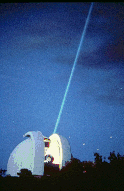Curved spacetime
This article's lead section may be too long. (September 2024) |
Newton's theories assumed that motion takes place against the backdrop of a rigid Euclidean reference frame that extends throughout all space and all time. Gravity is mediated by a mysterious force, acting instantaneously across a distance, whose actions are independent of the intervening space.[note 1] In contrast, Einstein denied that there is any background Euclidean reference frame that extends throughout space. Nor is there any such thing as a force of gravitation, only the structure of spacetime itself.[1]: 175–190
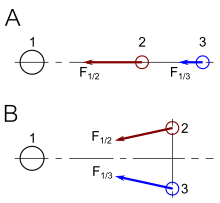
In spacetime terms, the path of a satellite orbiting the Earth is not dictated by the distant influences of the Earth, Moon and Sun. Instead, the satellite moves through space only in response to local conditions. Since spacetime is everywhere locally flat when considered on a sufficiently small scale, the satellite is always following a straight line in its local inertial frame. We say that the satellite always follows along the path of a geodesic. No evidence of gravitation can be discovered following alongside the motions of a single particle.[1]: 175–190
In any analysis of spacetime, evidence of gravitation requires that one observe the relative accelerations of two bodies or two separated particles. In Fig. 5-1, two separated particles, free-falling in the gravitational field of the Earth, exhibit tidal accelerations due to local inhomogeneities in the gravitational field such that each particle follows a different path through spacetime. The tidal accelerations that these particles exhibit with respect to each other do not require forces for their explanation. Rather, Einstein described them in terms of the geometry of spacetime, i.e. the curvature of spacetime. These tidal accelerations are strictly local. It is the cumulative total effect of many local manifestations of curvature that result in the appearance of a gravitational force acting at a long range from Earth.[1]: 175–190
Two central propositions underlie general relativity.
- The first crucial concept is coordinate independence: The laws of physics cannot depend on what coordinate system one uses. This is a major extension of the principle of relativity from the version used in special relativity, which states that the laws of physics must be the same for every observer moving in non-accelerated (inertial) reference frames. In general relativity, to use Einstein's own (translated) words, "the laws of physics must be of such a nature that they apply to systems of reference in any kind of motion."[2]: 113 This leads to an immediate issue: In accelerated frames, one feels forces that seemingly would enable one to assess one's state of acceleration in an absolute sense. Einstein resolved this problem through the principle of equivalence.[3]: 137–149

- The equivalence principle states that in any sufficiently small region of space, the effects of gravitation are the same as those from acceleration.
In Fig. 5-2, person A is in a spaceship, far from any massive objects, that undergoes a uniform acceleration of g. Person B is in a box resting on Earth. Provided that the spaceship is sufficiently small so that tidal effects are non-measurable (given the sensitivity of current gravity measurement instrumentation, A and B presumably should be Lilliputians), there are no experiments that A and B can perform which will enable them to tell which setting they are in.[3]: 141–149
An alternative expression of the equivalence principle is to note that in Newton's universal law of gravitation, F = GMmg/r2 = mgg and in Newton's second law, F = mia, there is no a priori reason why the gravitational mass mg should be equal to the inertial mass mi. The equivalence principle states that these two masses are identical.[3]: 141–149
To go from the elementary description above of curved spacetime to a complete description of gravitation requires tensor calculus and differential geometry, topics both requiring considerable study. Without these mathematical tools, it is possible to write about general relativity, but it is not possible to demonstrate any non-trivial derivations.
Curvature of time
[edit]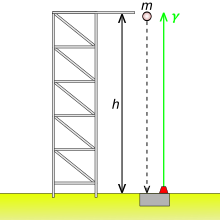
In the discussion of special relativity, forces played no more than a background role. Special relativity assumes the ability to define inertial frames that fill all of spacetime, all of whose clocks run at the same rate as the clock at the origin. Is this really possible? In a nonuniform gravitational field, experiment dictates that the answer is no. Gravitational fields make it impossible to construct a global inertial frame. In small enough regions of spacetime, local inertial frames are still possible. General relativity involves the systematic stitching together of these local frames into a more general picture of spacetime.[4]: 118–126
Years before publication of the general theory in 1916, Einstein used the equivalence principle to predict the existence of gravitational redshift in the following thought experiment: (i) Assume that a tower of height h (Fig. 5-3) has been constructed. (ii) Drop a particle of rest mass m from the top of the tower. It falls freely with acceleration g, reaching the ground with velocity v = (2gh)1/2, so that its total energy E, as measured by an observer on the ground, is (iii) A mass-energy converter transforms the total energy of the particle into a single high energy photon, which it directs upward. (iv) At the top of the tower, an energy-mass converter transforms the energy of the photon E' back into a particle of rest mass m'.[4]: 118–126
It must be that m = m', since otherwise one would be able to construct a perpetual motion device. We therefore predict that E' = m, so that
A photon climbing in Earth's gravitational field loses energy and is redshifted. Early attempts to measure this redshift through astronomical observations were somewhat inconclusive, but definitive laboratory observations were performed by Pound & Rebka (1959) and later by Pound & Snider (1964).[5]
Light has an associated frequency, and this frequency may be used to drive the workings of a clock. The gravitational redshift leads to an important conclusion about time itself: Gravity makes time run slower. Suppose we build two identical clocks whose rates are controlled by some stable atomic transition. Place one clock on top of the tower, while the other clock remains on the ground. An experimenter on top of the tower observes that signals from the ground clock are lower in frequency than those of the clock next to her on the tower. Light going up the tower is just a wave, and it is impossible for wave crests to disappear on the way up. Exactly as many oscillations of light arrive at the top of the tower as were emitted at the bottom. The experimenter concludes that the ground clock is running slow, and can confirm this by bringing the tower clock down to compare side by side with the ground clock.[6]: 16–18 For a 1 km tower, the discrepancy would amount to about 9.4 nanoseconds per day, easily measurable with modern instrumentation.
Clocks in a gravitational field do not all run at the same rate. Experiments such as the Pound–Rebka experiment have firmly established curvature of the time component of spacetime. The Pound–Rebka experiment says nothing about curvature of the space component of spacetime. But the theoretical arguments predicting gravitational time dilation do not depend on the details of general relativity at all. Any theory of gravity will predict gravitational time dilation if it respects the principle of equivalence.[6]: 16 This includes Newtonian gravitation. A standard demonstration in general relativity is to show how, in the "Newtonian limit" (i.e. the particles are moving slowly, the gravitational field is weak, and the field is static), curvature of time alone is sufficient to derive Newton's law of gravity.[7]: 101–106
Newtonian gravitation is a theory of curved time. General relativity is a theory of curved time and curved space. Given G as the gravitational constant, M as the mass of a Newtonian star, and orbiting bodies of insignificant mass at distance r from the star, the spacetime interval for Newtonian gravitation is one for which only the time coefficient is variable:[6]: 229–232
Curvature of space
[edit]The coefficient in front of describes the curvature of time in Newtonian gravitation, and this curvature completely accounts for all Newtonian gravitational effects. As expected, this correction factor is directly proportional to and , and because of the in the denominator, the correction factor increases as one approaches the gravitating body, meaning that time is curved.
But general relativity is a theory of curved space and curved time, so if there are terms modifying the spatial components of the spacetime interval presented above, should not their effects be seen on, say, planetary and satellite orbits due to curvature correction factors applied to the spatial terms?
The answer is that they are seen, but the effects are tiny. The reason is that planetary velocities are extremely small compared to the speed of light, so that for planets and satellites of the solar system, the term dwarfs the spatial terms.[6]: 234–238
Despite the minuteness of the spatial terms, the first indications that something was wrong with Newtonian gravitation were discovered over a century-and-a-half ago. In 1859, Urbain Le Verrier, in an analysis of available timed observations of transits of Mercury over the Sun's disk from 1697 to 1848, reported that known physics could not explain the orbit of Mercury, unless there possibly existed a planet or asteroid belt within the orbit of Mercury. The perihelion of Mercury's orbit exhibited an excess rate of precession over that which could be explained by the tugs of the other planets.[8] The ability to detect and accurately measure the minute value of this anomalous precession (only 43 arc seconds per tropical century) is testimony to the sophistication of 19th century astrometry.

As the astronomer who had earlier discovered the existence of Neptune "at the tip of his pen" by analyzing irregularities in the orbit of Uranus, Le Verrier's announcement triggered a two-decades long period of "Vulcan-mania", as professional and amateur astronomers alike hunted for the hypothetical new planet. This search included several false sightings of Vulcan. It was ultimately established that no such planet or asteroid belt existed.[9]
In 1916, Einstein was to show that this anomalous precession of Mercury is explained by the spatial terms in the curvature of spacetime. Curvature in the temporal term, being simply an expression of Newtonian gravitation, has no part in explaining this anomalous precession. The success of his calculation was a powerful indication to Einstein's peers that the general theory of relativity could be correct.
The most spectacular of Einstein's predictions was his calculation that the curvature terms in the spatial components of the spacetime interval could be measured in the bending of light around a massive body. Light has a slope of ±1 on a spacetime diagram. Its movement in space is equal to its movement in time. For the weak field expression of the invariant interval, Einstein calculated an exactly equal but opposite sign curvature in its spatial components.[6]: 234–238
In Newton's gravitation, the coefficient in front of predicts bending of light around a star. In general relativity, the coefficient in front of predicts a doubling of the total bending.[6]: 234–238
The story of the 1919 Eddington eclipse expedition and Einstein's rise to fame is well told elsewhere.[10]
Sources of spacetime curvature
[edit]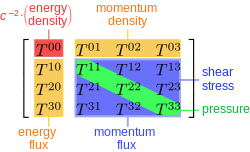
In Newton's theory of gravitation, the only source of gravitational force is mass.
In contrast, general relativity identifies several sources of spacetime curvature in addition to mass. In the Einstein field equations, the sources of gravity are presented on the right-hand side in the stress–energy tensor.[11]
Fig. 5-5 classifies the various sources of gravity in the stress–energy tensor:
- (red): The total mass–energy density, including any contributions to the potential energy from forces between the particles, as well as kinetic energy from random thermal motions.
- and (orange): These are momentum density terms. Even if there is no bulk motion, energy may be transmitted by heat conduction, and the conducted energy will carry momentum.
- are the rates of flow of the i-component of momentum per unit area in the j-direction. Even if there is no bulk motion, random thermal motions of the particles will give rise to momentum flow, so the i = j terms (green) represent isotropic pressure, and the i ≠ j terms (blue) represent shear stresses.[11]
One important conclusion to be derived from the equations is that, colloquially speaking, gravity itself creates gravity.[note 2] Energy has mass. Even in Newtonian gravity, the gravitational field is associated with an energy, called the gravitational potential energy. In general relativity, the energy of the gravitational field feeds back into creation of the gravitational field. This makes the equations nonlinear and hard to solve in anything other than weak field cases.[6]: 240 Numerical relativity is a branch of general relativity using numerical methods to solve and analyze problems, often employing supercomputers to study black holes, gravitational waves, neutron stars and other phenomena in the strong field regime.
Energy-momentum
[edit]In special relativity, mass-energy is closely connected to momentum. Just as space and time are different aspects of a more comprehensive entity called spacetime, mass–energy and momentum are merely different aspects of a unified, four-dimensional quantity called four-momentum. In consequence, if mass–energy is a source of gravity, momentum must also be a source. The inclusion of momentum as a source of gravity leads to the prediction that moving or rotating masses can generate fields analogous to the magnetic fields generated by moving charges, a phenomenon known as gravitomagnetism.[12]

It is well known that the force of magnetism can be deduced by applying the rules of special relativity to moving charges. (An eloquent demonstration of this was presented by Feynman in volume II, chapter 13–6 of his Lectures on Physics, available online.)[13] Analogous logic can be used to demonstrate the origin of gravitomagnetism.[6]: 245–253
In Fig. 5-7a, two parallel, infinitely long streams of massive particles have equal and opposite velocities −v and +v relative to a test particle at rest and centered between the two. Because of the symmetry of the setup, the net force on the central particle is zero. Assume so that velocities are simply additive. Fig. 5-7b shows exactly the same setup, but in the frame of the upper stream. The test particle has a velocity of +v, and the bottom stream has a velocity of +2v. Since the physical situation has not changed, only the frame in which things are observed, the test particle should not be attracted towards either stream.[6]: 245–253
It is not at all clear that the forces exerted on the test particle are equal. (1) Since the bottom stream is moving faster than the top, each particle in the bottom stream has a larger mass energy than a particle in the top. (2) Because of Lorentz contraction, there are more particles per unit length in the bottom stream than in the top stream. (3) Another contribution to the active gravitational mass of the bottom stream comes from an additional pressure term which, at this point, we do not have sufficient background to discuss. All of these effects together would seemingly demand that the test particle be drawn towards the bottom stream.[6]: 245–253
The test particle is not drawn to the bottom stream because of a velocity-dependent force that serves to repel a particle that is moving in the same direction as the bottom stream. This velocity-dependent gravitational effect is gravitomagnetism.[6]: 245–253
Matter in motion through a gravitomagnetic field is hence subject to so-called frame-dragging effects analogous to electromagnetic induction. It has been proposed that such gravitomagnetic forces underlie the generation of the relativistic jets (Fig. 5-8) ejected by some rotating supermassive black holes.[14][15]
Pressure and stress
[edit]Quantities that are directly related to energy and momentum should be sources of gravity as well, namely internal pressure and stress. Taken together, mass-energy, momentum, pressure and stress all serve as sources of gravity: Collectively, they are what tells spacetime how to curve.
General relativity predicts that pressure acts as a gravitational source with exactly the same strength as mass–energy density. The inclusion of pressure as a source of gravity leads to dramatic differences between the predictions of general relativity versus those of Newtonian gravitation. For example, the pressure term sets a maximum limit to the mass of a neutron star. The more massive a neutron star, the more pressure is required to support its weight against gravity. The increased pressure, however, adds to the gravity acting on the star's mass. Above a certain mass determined by the Tolman–Oppenheimer–Volkoff limit, the process becomes runaway and the neutron star collapses to a black hole.[6]: 243, 280
The stress terms become highly significant when performing calculations such as hydrodynamic simulations of core-collapse supernovae.[16]
These predictions for the roles of pressure, momentum and stress as sources of spacetime curvature are elegant and play an important role in theory. In regards to pressure, the early universe was radiation dominated,[17] and it is highly unlikely that any of the relevant cosmological data (e.g. nucleosynthesis abundances, etc.) could be reproduced if pressure did not contribute to gravity, or if it did not have the same strength as a source of gravity as mass–energy. Likewise, the mathematical consistency of the Einstein field equations would be broken if the stress terms did not contribute as a source of gravity.
Experimental test of the sources of spacetime curvature
[edit]Definitions: Active, passive, and inertial mass
[edit]Bondi distinguishes between different possible types of mass: (1) active mass () is the mass which acts as the source of a gravitational field; (2)passive mass () is the mass which reacts to a gravitational field; (3) inertial mass () is the mass which reacts to acceleration.[18]
- is the same as gravitational mass () in the discussion of the equivalence principle.
In Newtonian theory,
- The third law of action and reaction dictates that and must be the same.
- On the other hand, whether and are equal is an empirical result.
In general relativity,
- The equality of and is dictated by the equivalence principle.
- There is no "action and reaction" principle dictating any necessary relationship between and .[18]
Pressure as a gravitational source
[edit]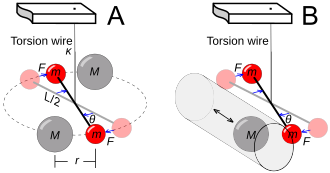
The classic experiment to measure the strength of a gravitational source (i.e. its active mass) was first conducted in 1797 by Henry Cavendish (Fig. 5-9a). Two small but dense balls are suspended on a fine wire, making a torsion balance. Bringing two large test masses close to the balls introduces a detectable torque. Given the dimensions of the apparatus and the measurable spring constant of the torsion wire, the gravitational constant G can be determined.
To study pressure effects by compressing the test masses is hopeless, because attainable laboratory pressures are insignificant in comparison with the mass-energy of a metal ball.
However, the repulsive electromagnetic pressures resulting from protons being tightly squeezed inside atomic nuclei are typically on the order of 1028 atm ≈ 1033 Pa ≈ 1033 kg·s−2m−1. This amounts to about 1% of the nuclear mass density of approximately 1018kg/m3 (after factoring in c2 ≈ 9×1016m2s−2).[19]
If pressure does not act as a gravitational source, then the ratio should be lower for nuclei with higher atomic number Z, in which the electrostatic pressures are higher. L. B. Kreuzer (1968) did a Cavendish experiment using a Teflon mass suspended in a mixture of the liquids trichloroethylene and dibromoethane having the same buoyant density as the Teflon (Fig. 5-9b). Fluorine has atomic number Z = 9, while bromine has Z = 35. Kreuzer found that repositioning the Teflon mass caused no differential deflection of the torsion bar, hence establishing active mass and passive mass to be equivalent to a precision of 5×10−5.[20]
Although Kreuzer originally considered this experiment merely to be a test of the ratio of active mass to passive mass, Clifford Will (1976) reinterpreted the experiment as a fundamental test of the coupling of sources to gravitational fields.[21]
In 1986, Bartlett and Van Buren noted that lunar laser ranging had detected a 2 km offset between the moon's center of figure and its center of mass. This indicates an asymmetry in the distribution of Fe (abundant in the Moon's core) and Al (abundant in its crust and mantle). If pressure did not contribute equally to spacetime curvature as does mass–energy, the moon would not be in the orbit predicted by classical mechanics. They used their measurements to tighten the limits on any discrepancies between active and passive mass to about 10−12.[22] With decades of additional lunar laser ranging data, Singh et al. (2023) reported improvement on these limits by a factor of about 100.[23]
Gravitomagnetism
[edit]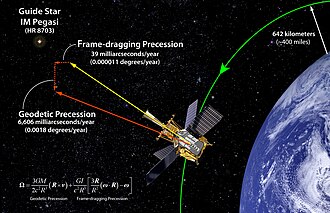
The existence of gravitomagnetism was proven by Gravity Probe B (GP-B), a satellite-based mission which launched on 20 April 2004.[24] The spaceflight phase lasted until . The mission aim was to measure spacetime curvature near Earth, with particular emphasis on gravitomagnetism.
Initial results confirmed the relatively large geodetic effect (which is due to simple spacetime curvature, and is also known as de Sitter precession) to an accuracy of about 1%. The much smaller frame-dragging effect (which is due to gravitomagnetism, and is also known as Lense–Thirring precession) was difficult to measure because of unexpected charge effects causing variable drift in the gyroscopes. Nevertheless, by , the frame-dragging effect had been confirmed to within 15% of the expected result,[25] while the geodetic effect was confirmed to better than 0.5%.[26][27]
Subsequent measurements of frame dragging by laser-ranging observations of the LARES, LAGEOS-1 and LAGEOS-2 satellites has improved on the GP-B measurement, with results (as of 2016) demonstrating the effect to within 5% of its theoretical value,[28] although there has been some disagreement on the accuracy of this result.[29]
Another effort, the Gyroscopes in General Relativity (GINGER) experiment, seeks to use three 6 m ring lasers mounted at right angles to each other 1400 m below the Earth's surface to measure this effect.[30][31]
Notes
[edit]- ^ Newton himself was acutely aware of the inherent difficulties with these assumptions, but as a practical matter, making these assumptions was the only way that he could make progress. In 1692, he wrote to his friend Richard Bentley: "That Gravity should be innate, inherent and essential to Matter, so that one body may act upon another at a distance thro' a Vacuum, without the Mediation of any thing else, by and through which their Action and Force may be conveyed from one to another, is to me so great an Absurdity that I believe no Man who has in philosophical Matters a competent Faculty of thinking can ever fall into it."
- ^ More precisely, the gravitational field couples to itself. In Newtonian gravity, the potential due to two point masses is simply the sum of the potentials of the two masses, but this does not apply to GR. This can be thought of as the result of the equivalence principle: If gravitation did not couple to itself, two particles bound by their mutual gravitational attraction would not have the same inertial mass (due to negative binding energy) as their gravitational mass.[7]: 112–113
- ^ Different reporters viewing the scenarios presented in this figure interpret the scenarios differently depending on their knowledge of the situation. (i) A first reporter, at the center of mass of particles 2 and 3 but unaware of the large mass 1, concludes that a force of repulsion exists between the particles in scenario A while a force of attraction exists between the particles in scenario B. (ii) A second reporter, aware of the large mass 1, smiles at the first reporter's naiveté. This second reporter knows that in reality, the apparent forces between particles 2 and 3 really represent tidal effects resulting from their differential attraction by mass 1. (iii) A third reporter, trained in general relativity, knows that there are, in fact, no forces at all acting between the three objects. Rather, all three objects move along geodesics in spacetime.
References
[edit]- ^ a b c Taylor, Edwin F.; Wheeler, John Archibald (1992). Spacetime Physics: Introduction to Special Relativity (2nd ed.). San Francisco, California: Freeman. ISBN 0-7167-0336-X. Retrieved 14 April 2017.
- ^ Lorentz, H. A.; Einstein, A.; Minkowski, H.; Weyl, H. (1952). The Principle of Relativity: A Collection of Original Memoirs on the Special and General Theory of Relativity. Dover Publications. ISBN 0-486-60081-5.
- ^ a b c Mook, Delo E.; Vargish, Thoma s (1987). Inside Relativity. Princeton, New Jersey: Princeton University Press. ISBN 0-691-08472-6.
- ^ a b Schutz, Bernard F. (1985). A first course in general relativity. Cambridge, UK: Cambridge University Press. p. 26. ISBN 0-521-27703-5.
- ^ Mester, John. "Experimental Tests of General Relativity" (PDF). Laboratoire Univers et Théories. Archived from the original (PDF) on 18 March 2017. Retrieved 9 June 2017.
- ^ a b c d e f g h i j k l Schutz, Bernard (2004). Gravity from the Ground Up: An Introductory Guide to Gravity and General Relativity (Reprint ed.). Cambridge: Cambridge University Press. ISBN 0-521-45506-5. Archived from the original on 17 January 2023. Retrieved 24 May 2017.
- ^ a b Carroll, Sean M. (2 December 1997). "Lecture Notes on General Relativity". arXiv:gr-qc/9712019.
- ^ Le Verrier, Urbain (1859). "Lettre de M. Le Verrier à M. Faye sur la théorie de Mercure et sur le mouvement du périhélie de cette planète". Comptes rendus hebdomadaires des séances de l'Académie des Sciences. 49: 379–383.
- ^ Worrall, Simon (4 November 2015). "The Hunt for Vulcan, the Planet That Wasn't There". National Geographic. Archived from the original on 24 May 2017.
- ^ Levine, Alaina G. (May 2016). "May 29, 1919: Eddington Observes Solar Eclipse to Test General Relativity". This Month in Physics History. APS News. American Physical Society. Archived from the original on 2 June 2017.
- ^ a b Hobson, M. P.; Efstathiou, G.; Lasenby, A. N. (2006). General Relativity. Cambridge: Cambridge University Press. pp. 176–179. ISBN 978-0-521-82951-9.
- ^ Thorne, Kip S. (1988). Fairbank, J. D.; Deaver, B. S. Jr.; Everitt, W. F.; Michelson, P. F. (eds.). Near zero: New Frontiers of Physics (PDF). W. H. Freeman and Company. pp. 573–586. S2CID 12925169. Archived from the original (PDF) on 28 July 2017.
- ^ Feynman, R. P.; Leighton, R. B.; Sands, M. (1964). The Feynman Lectures on Physics, vol. 2 (New Millenium ed.). Basic Books. pp. 13–6 to 13–11. ISBN 978-0-465-02416-2. Archived from the original on 17 January 2023. Retrieved 1 July 2017.
- ^ Williams, R. K. (1995). "Extracting X rays, Ύ rays, and relativistic e−–e+ pairs from supermassive Kerr black holes using the Penrose mechanism". Physical Review D. 51 (10): 5387–5427. Bibcode:1995PhRvD..51.5387W. doi:10.1103/PhysRevD.51.5387. PMID 10018300.
- ^ Williams, R. K. (2004). "Collimated escaping vortical polar e−–e+ jets intrinsically produced by rotating black holes and Penrose processes". The Astrophysical Journal. 611 (2): 952–963. arXiv:astro-ph/0404135. Bibcode:2004ApJ...611..952W. doi:10.1086/422304. S2CID 1350543.
- ^ Kuroda, Takami; Kotake, Kei; Takiwaki, Tomoya (2012). "Fully General Relativistic Simulations of Core-Collapse Supernovae with An Approximate Neutrino Transport". The Astrophysical Journal. 755 (1): 11. arXiv:1202.2487. Bibcode:2012ApJ...755...11K. doi:10.1088/0004-637X/755/1/11. S2CID 119179339.
- ^ Wollack, Edward J. (10 December 2010). "Cosmology: The Study of the Universe". Universe 101: Big Bang Theory. NASA. Archived from the original on 14 May 2011. Retrieved 15 April 2017.
- ^ a b Bondi, Hermann (1957). DeWitt, Cecile M.; Rickles, Dean (eds.). The Role of Gravitation in Physics: Report from the 1957 Chapel Hill Conference. Berlin, Germany: Max Planck Research Library. pp. 159–162. ISBN 978-3-86931-963-6. Archived from the original on 28 July 2017. Retrieved 1 July 2017.
- ^ Crowell, Benjamin (2000). General Relativity. Fullerton, CA: Light and Matter. pp. 241–258. Archived from the original on 18 June 2017. Retrieved 30 June 2017.
- ^ Kreuzer, L. B. (1968). "Experimental measurement of the equivalence of active and passive gravitational mass". Physical Review. 169 (5): 1007–1011. Bibcode:1968PhRv..169.1007K. doi:10.1103/PhysRev.169.1007.
- ^ Will, C. M. (1976). "Active mass in relativistic gravity-Theoretical interpretation of the Kreuzer experiment". The Astrophysical Journal. 204: 224–234. Bibcode:1976ApJ...204..224W. doi:10.1086/154164. Archived from the original on 28 September 2018. Retrieved 2 July 2017.
- ^ Bartlett, D. F.; Van Buren, Dave (1986). "Equivalence of active and passive gravitational mass using the moon". Physical Review Letters. 57 (1): 21–24. Bibcode:1986PhRvL..57...21B. doi:10.1103/PhysRevLett.57.21. PMID 10033347.
- ^ Singh, Vishwa Vijay; Müller, Jürgen; Biskupek, Liliane; Hackmann, Eva; Lämmerzahl, Claus (2023). "Equivalence of Active and Passive Gravitational Mass Tested with Lunar Laser Ranging". Physical Review Letters. 131 (2): 021401. arXiv:2212.09407. Bibcode:2023PhRvL.131b1401S. doi:10.1103/PhysRevLett.131.021401. PMID 37505941. Retrieved 7 March 2024.
- ^ "Gravity Probe B: FAQ". Archived from the original on 2 June 2018. Retrieved 2 July 2017.
- ^ Gugliotta, G. (16 February 2009). "Perseverance Is Paying Off for a Test of Relativity in Space". New York Times. Archived from the original on 3 September 2018. Retrieved 2 July 2017.
- ^ Everitt, C. W. F.; Parkinson, B. W. (2009). "Gravity Probe B Science Results—NASA Final Report" (PDF). Archived (PDF) from the original on 23 October 2012. Retrieved 2 July 2017.
- ^ Everitt; et al. (2011). "Gravity Probe B: Final Results of a Space Experiment to Test General Relativity". Physical Review Letters. 106 (22): 221101. arXiv:1105.3456. Bibcode:2011PhRvL.106v1101E. doi:10.1103/PhysRevLett.106.221101. PMID 21702590. S2CID 11878715.
- ^ Ciufolini, Ignazio; Paolozzi, Antonio Rolf Koenig; Pavlis, Erricos C.; Koenig, Rolf (2016). "A test of general relativity using the LARES and LAGEOS satellites and a GRACE Earth gravity model". European Physical Journal C. 76 (3): 120. arXiv:1603.09674. Bibcode:2016EPJC...76..120C. doi:10.1140/epjc/s10052-016-3961-8. PMC 4946852. PMID 27471430.
- ^ Iorio, L. (February 2017). "A comment on "A test of general relativity using the LARES and LAGEOS satellites and a GRACE Earth gravity model. Measurement of Earth's dragging of inertial frames," by I. Ciufolini et al". The European Physical Journal C. 77 (2): 73. arXiv:1701.06474. Bibcode:2017EPJC...77...73I. doi:10.1140/epjc/s10052-017-4607-1. S2CID 118945777.
- ^ Cartlidge, Edwin (20 January 2016). "Underground ring lasers will put general relativity to the test". physicsworld.com. Institute of Physics. Archived from the original on 12 July 2017. Retrieved 2 July 2017.
- ^ "Einstein right using the most sensitive Earth rotation sensors ever made". Phys.org. Science X network. Archived from the original on 10 May 2017. Retrieved 2 July 2017.










![{\displaystyle -\,\left(1+{\frac {2GM}{c^{2}r}}\right)\left[(\Delta x)^{2}+(\Delta y)^{2}+(\Delta z)^{2}\right]}](https://wikimedia.org/api/rest_v1/media/math/render/svg/e004b8eb220d5cc0f0e835a4f9a584ebfdc3ef02)

![{\displaystyle \left[(\Delta x)^{2}+(\Delta y)^{2}+(\Delta z)^{2}\right]}](https://wikimedia.org/api/rest_v1/media/math/render/svg/b88b386b994cad15b04251eedd908b3828db4d66)














